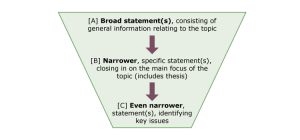Learn about good essay structure and familiarise yourself with different essay types and examples.
Essays are one form of assessment at university. To write a good essay, you need to show that you have understood the assignment question and built your discussion based on what you have learnt through the literature. You will need to present your ideas in a logical structure so that they are easy to follow.
How to structure an essay
It is important to present your ideas in the correct essay structure which consists of: Essay topic (or title or question), introduction, body, conclusion, references.
- Basic structure of an academic essay (PDF)
- Example of an essay outline (PDF)
“Discuss the effects of the unemployment benefit system on the New Zealand economy.”
The introduction paragraph is normally about 10-15% of the total essay length.
A good introduction paragraph:
- Provides background or scope context to your essay.
- Introduces the essay topic.
- States the main point of your essay in a thesis statement in one or two sentences.
- Shows in the last one or two sentences what you plan to cover in the body paragraphs.

A – Broad statement(s) consisting of general information relating to the topic.
B – Narrower, specific statement(s), closing in on the main focus of the topic (includes thesis).
C – Even narrower, statement(s), identifying key issues.
Learn more about:
The body paragraphs address each of the main points (or sub-topics) of your essay in the same order they were mentioned in your essay introduction. Each paragraph will be related to your essay’s central focus and thesis.
- Before you start to write, draw a map of your ideas for the different paragraphs which support the thesis statement.
- After you have made your map, write each body paragraph with a clear structure to describe, discuss and develop your topic.
Learn more about writing good essay body paragraphs from the Essay writing resource website.
The conclusion paragraph is your last chance to impress your reader. You can either:
- Start your conclusion with a phrase such as “In conclusion” or “To sum up” as this will indicate to your reader that you are finishing your essay.
- Immediately begin with a summary of the main points, and then write an end statement. In this statement you can restate the thesis, make final comments that could be evaluative, or refer to the larger issues related to the larger context or background.
Learn more about writing good essay conclusions from the Essay writing resource website.
Learn more about referencing.
What are common essay types?
At university you have to demonstrate the ability to write different types of essays. While all academic essays have the same basic structure (introduction, body paragraphs, conclusion), the purpose, style of delivery, and organisation of the ideas may vary.
Examples of common essay types
“A discussion essay discusses a range of evidence, views, theories, findings or approaches on a topic to develop a position through the essay. The conclusion usually states this position” Academic Writing at Auckland (AWA).
See the discussion essay examples on the AWA site.
“An Analysis Essay critically analyses an object of study (a book extract, artwork, film, article, cultural artefact, event, example, situation…) through the lens of broader concepts (theories, themes, values, systems, processes…). It builds and supports a position and argument through this critical analysis and demonstrates understanding of both the object and the broader concepts” Academic Writing at Auckland (AWA).
See the analysis essay examples on the AWA site.
See the argument essay examples on the AWA site.
Additional resources
The following resources provide you further information about essay writing and examples of essays in different disciplines:

